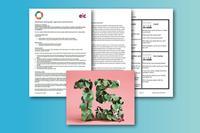How mass ammonia-based fertiliser production has helped and hindered our species and others
Sustainable development, defined as meeting the needs of current generations without compromising the ability of future generations to meet their own needs, is desperately needed. Meeting UN Sustainable development goal 15 is crucial in helping support our species and mitigating the adverse impacts we have had on other species and the land we all rely on, eg through the extensive application of ammonia-based fertilisers.
This resource involves a group activity in which learners are grouped into fours and initial reciprocal reading roles are allocated. The roles are: predict; clarify; summarise; question. The learners then use the reciprocal reading roles handout and a text on agriculture and ammonia, included in the download, to discuss and ask questions of each other and the text.
Learning objectives
- Work together to decode the text and draw links to their curriculum knowledge.
- Develop skills in oracy and metacognition; improve their ability to read for meaning.

Sustainability in chemistry

This resource accompanies the Education in Chemistry article Sustainable use of terrestrial ecosystems where you will find more support and suggestions for how to connect your current chemistry teaching with UN sustainable development goal 15: protect, restore and promote sustainable use of terrestrial ecosystems, sustainably manage forests, combat desertification, halt and reverse land degradation, halt biodiversity loss.
Instructions
Using the reciprocal reading handout, ensure each learner understands all the roles, not just their starting role.
1. The learner with the predict role scans the first paragraph of the text, predicts what they think the text is about and suggests how it links to the topic being studied. They then read the first paragraph to the group.
2. The learner with the summarise role highlights the key ideas up to this point in the reading.
3. The learner with the question and build role asks questions about the paragraph and builds connections to other concepts already learned.
4. The learner with the clarify role addresses confusing parts and attempts to answer the questions posed. They may need to ask other members of the group to help them, use a textbook/internet search or ask the teacher for help.
5. The roles in the group then switch one person to the right, and the next section is read. Learners repeat the process using their new roles.
6. This continues until the entire text is read.
Teaching notes
Arrange the groups and choose one group to help model the process. Explain what the learners must do. Using another piece of text and the model group demonstrate the roles and process. Emphasise that the text and discussion is the activity, they are the creators of the questions and answers.
Throughout the process, the teacher’s role is to guide and nurture the learners’ ability to use the four strategies successfully within the small group. When observing the learners try to note the level of participation and their strategy competence. These observations form the basis of future planning and teaching.
Once learners become competent in this technique, research suggests the process will be internalised and transferred to their independent reading as a metacognitive strategy. The task provides context and helps build cultural and science capital.
Tip: encourage learners to use note-taking strategies such as selective underlining or sticky notes to help them better prepare for their role in the discussion.
Link global food security to your lessons on fertilisers and enhance your teaching in this topic area with the UN Sustainable development goal 2 (end hunger, achieve food security and improved nutrition and promote sustainable agriculture) article in this series.
Find more resources
- Help create context with real-life examples of molecules, such as Acmella olerace.
- Link to careers with this job profile of an environmental chemist who assesses the risks to life from certain chemicals in soil, water and air; find more inspiration with our Fixing the future video.
- Why not partner with students and colleagues to work towards becoming an Eco-school?
Downloads
Agriculture and ammonia reciprocal reading task
Handout | PDF, Size 0.18 mbAgriculture and ammonia reciprocal reading task
Editable handout | Word, Size 0.16 mb



















No comments yet